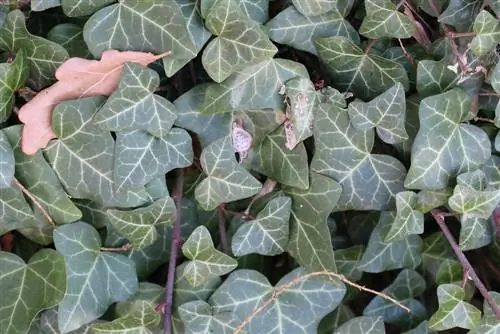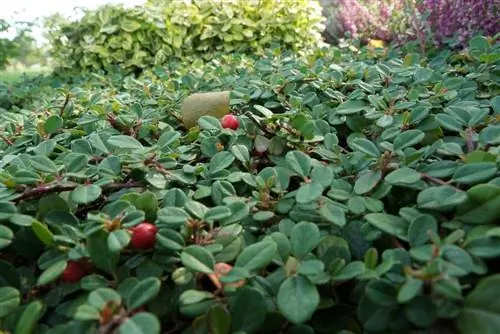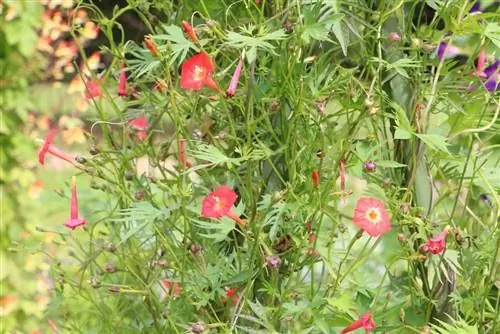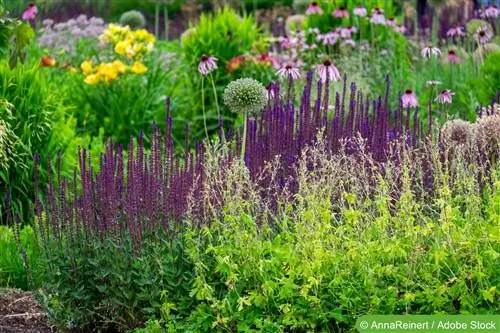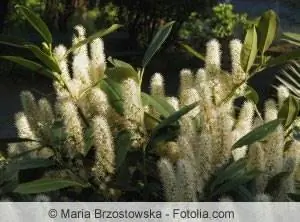- Author admin [email protected].
- Public 2023-12-17 03:39.
- Last modified 2025-06-01 06:48.
Nothing disrupts the beautiful composition of a garden more than bare areas. They take away its harmonious appearance and make it appear unfinished and unkempt. Evergreen flowering ground cover closes these gaps sustainably and without much maintenance. In a short time they form a closed cover that is decorated with flowers and fruits from spring to autumn. Once planted, the perennials and small trees reliably develop into long-lasting garden decorations. Whether for shady or sunny locations, evergreen ground cover is available for all locations and requirements.
Important planting and care instructions
A rule of thumb says: Late summer is the best time to plant evergreen ground cover plants in the ground. The reason for this is convincing. As the beautiful season comes to an end, the growth of the weeds also decreases. The empty areas between the young plants can no longer be overgrown by unwanted intruders. However, this planting time is not optimal for all ground cover plants. Therefore, the information provided by nurseries and breeders always takes precedence. But whatever the season, the planting area must be thoroughly cleaned and well prepared in advance:
- Remove root weeds such as couch grass and groundweed completely
- To loosen the soil deeply to ensure good oxygen supply and rapid rooting
- Compost additions are only necessary for very heavy and very light soils
Evergreen ground covers are generally robust and undemanding and do not require any fertilizer. Please note: Hoeing between small plants is taboo. It could damage their roots, which always spread horizontally. A practical tip: A layer of bark mulch, underlaid with horn shavings, protects the soil from weeds until the desired green cover has formed.
Varieties for sunny places
- The carpet golden strawberry (Waldsteinia ternata) appeals with its lush green leaves and strikingly dense growth. It grows to a height of almost ten centimeters. From mid-April to early June they are decorated with small yolk-yellow flowers. This evergreen ground cover loves humus-rich and not too dry soil. It also feels comfortable in light partial shade. Because it only has short runners, it can easily be planted densely so that the area quickly becomes impenetrable.
- The carpet verbena (Phyla nodiflora) is a Japanese variety that impresses with its excellent properties. No other variety grows as quickly as it does. The green cover is closed within just a few weeks. It is also very unusually robust and insensitive. The area, which is only three to four centimeters high, can be walked on without hesitation without causing any damage to the plants. In addition, their flowering period is unusually long. From May to October it is decorated with delicate white, slightly pink stars.
- The cotoneaster (cotoneaster) is available in numerous, attractive varieties. She loves sun without restrictions. The more light and warmth it receives, the denser the flowers that cover it from June onwards become. Small red fruits form in autumn, which form a nice contrast to the evergreen foliage. The cotoneaster is robust, but requires more care than other evergreen ground cover plants. It appreciates fertilizer at regular intervals and should also be watered during long dry periods.
Varieties for shady places
- The native evergreen (Vinca) loves shade and moist soil. Its long shoots are covered with small leathery leaves. Depending on the variety, blue, white or red-violet flowers appear between April and June. It forms a dense carpet under bushes and trees. A tip: Periwinkle forms a decorative frame for the first spring flowers such as daffodils, whose bulbs are placed in the ground the same year they are planted.
- Fat Man or Ysander (Pachysandra terminalis) is an evergreen boxwood plant that thrives excellently under dark trees. No ground cover tolerates more shade and root pressure than him. It also feels comfortable in difficult corners where nothing else wants to grow. From April to May it is adorned with large numbers of small and inconspicuous white flowers.
- The delicate flower clusters that this striking evergreen ground cover shows between April and May are as pretty as its name, elf flower. It is offered in red, yellow, white and lavender. In order to quickly achieve a closed plant cover, we recommend choosing a clump-forming variety. In contrast to those that develop runners, they can be planted close together from the start.
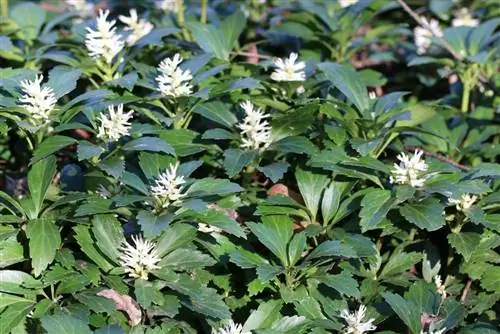
Other recommended varieties
- Prickly nut (Acaena)
- Holy Herb (Santolina)
- Hazelroot (Asarum europaeum)
- Candytuft (Iberis sempervirens)
- Evergreen creeping spindle (Euonymus fortunei)
- Silverwort (Dryas)
- Andean cushion (Azorella trifurcata)
- Houseleek (Sempervivum)
- Peat myrtle (Pernettya mucronata)
- Black crowberry (Empetrum nigrum)
Frequently asked questions
Is there a specified planting density?
The planting density is different for every plant. It is always stated on the pots and should be strictly adhered to. Why? If evergreen ground cover plants are planted too densely, they quickly block each other's light. They then become disproportionately high and no longer form a harmonious overall picture. If they are planted too far apart, they will require a disproportionate amount of time to form the closed cover. There is also the risk of weeds getting in between them, which are difficult to remove.
What about winter protection?
Basically, evergreen ground covers are hardy and therefore do not need any special protection in the cold season. Neither snow nor leaf infestation harms them. However, some varieties may weaken in extremely cold winters. This is shown by discolored leaves or bald spots that form. By the beginning of summer, the planting will certainly have recovered from these effects.
How can overgrowth be prevented?
In the beginning there is great joy about the lush growth and the rapid spreading of evergreen ground cover. However, it can happen that it becomes too much of a good thing and needs to be limited. Since the plants have shallow roots, this is easily possible across natural barriers. These include, for example, stones and logs embedded in the ground. Cost-intensive root barriers are not necessary.
What you need to know about important evergreen ground covers
Pernettya - Peat Myrtle
Pernettya mucronata, native to Chile and Tierra del Fuego, shows its best side twice a year. From late spring to early summer, its wiry stems are draped in a white veil of flowers reminiscent of those of heather, and in autumn and winter it adorns itself with marble-sized, shiny berries. Because of its low growth habit, the evergreen peat myrtle is often grown as a ground cover in gardens with acidic soil. In cold areas, a cover of leaves or brushwood is recommended as winter protection.
Potentilla - crabwort
The crab bush owes its great popularity to the never-ending display of colorful flowers from early summer to autumn. The cup-shaped flowers are usually undouble, but there are also double varieties. Depending on the species or variety, these plants develop into roundish, bushy shrubs that are suitable for bed planting, or they grow low and creep and are therefore ideal as ground cover.
Andromeda - Lavender Heath
The native lavender heather grows in acidic raised bogs on peat and is one of the threatened and therefore protected plants in our country. As a typical ericaceous plant, it only thrives in moist and sufficiently acidic substrates. The evergreen leaves of the shrub are reminiscent of those of rosemary “Compacta”, with its decorative light pink flowers it is a popular variety.
Cytisus - Black Clover
Honey clover forms a large group of shrubs that is popular primarily because of its abundance of flowers from the end of spring to mid-summer. The flowers are yellow, creamy white, red or purple. Honeysuckle bushes look particularly good in front of walls and as borders, while low species are suitable as ground cover in rock gardens.
Ivy
Ivy, which is widespread from the Canary Islands across Europe to East Asia, is one of the climbing plants that hardly causes any problems; it tolerates all soils and locations. Although it also produces flowers and fruits, it owes its popularity primarily to its evergreen foliage. In the course of its development, the shoots show two different types of growth: The young shoots produce lobed leaves and hold on to any substrate with the help of adhesive roots, the older, fully grown shoot parts have unlobed leaves with wavy edges and do not form adhesive roots, but are bearable Inflorescences and slightly poisonous fruits. Ivy is also very popular as an evergreen ground cover.
Vinca - Periwinkle
The fast-growing evergreen is a popular ground cover for semi-shady locations. With its long creeping shoots, each plant covers an area of 0.9 - 1.2 m². The blue, purple or white flowers appear mainly in spring and summer.

